May 6, 2020

The Black Death (1347-51) devastated European society. Writing four decades after the event, the English monk and chronicler, Thomas Walsingham, remarked that “so much wretchedness followed these ills that afterwards the world could never return to its former state.”
This medieval commentary reflects a lived reality: a world turned upside down by mass fear, contagion and death.
Yet society recovered. Life continued despite the uncertainty. But it was not “business-as-usual” in the aftermath — the threat of plague remained.
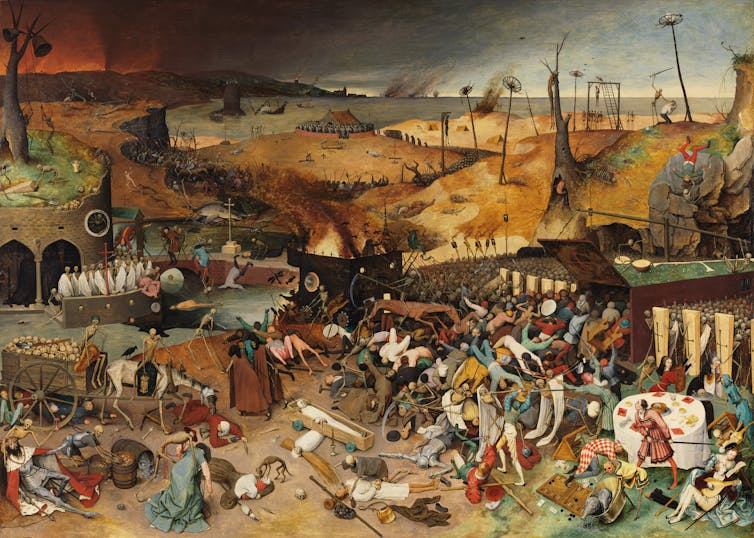
The Triumph of Death by Pieter Bruegel the Elder shows a devastated landscape where death is taking people indiscriminately as it appeared to during a wave of plague. (Museo del Prado)
Slow and painful recovery
The post-Black Death world had “not been made any better by its renewal.” The French monk, Guillaume de Nangis, lamented that men were more “miserly and grasping,” “greedy and quarrelsome” and involved in more “brawls, disputes and lawsuits.”
The shortage of workers in the aftermath was acute. The contemporary Historia Roffensis notes that swaths of land in England “remained uncultivated,” in a world dependent on agricultural production.
A scarcity of goods soon followed, forcing some landlords in the realm to lower or pardon rents in order to keep their tenants. “If labourers work not,” quipped the English preacher, Thomas Wimbledon, “priests and knights must become cultivators and herdsmen, or else die for want of bodily sustenance.”
Sometimes, the stimulus came by force. In 1349, the English government issued its Ordinance of Laborers, which legislated able-bodied men and women be paid salaries and wages at the pre-plague 1346 rate.
Other times, the recovery was more organic. According to the French Carmelite friar, Jean de Venette, “everywhere women conceived more readily than usual;” none was barren and pregnant women abounded. Several gave birth to twins and triplets, signalling a new age in the aftermath of such a great mortality.
A common and familiar enemy
Then the plague returned. A second pestilence struck England in 1361. A third wave affected several other countries in 1369. A fourth and fifth wave followed in 1374-79 and 1390-93 respectively
.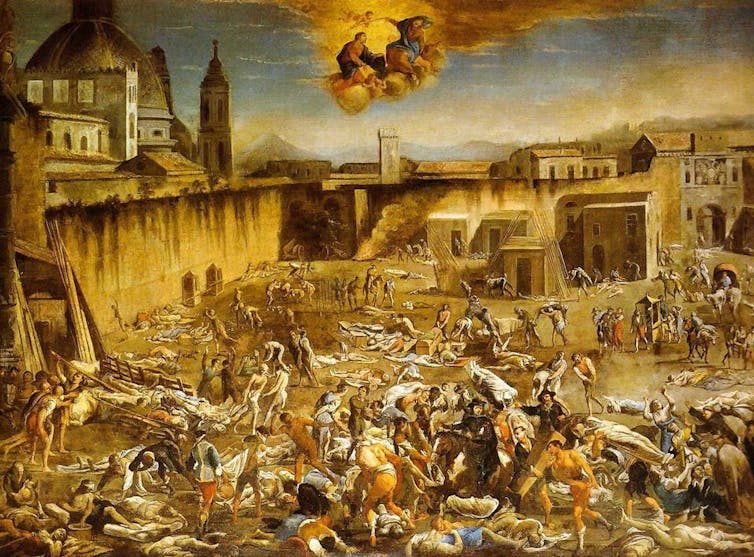

A painting by Domenico Gargiulo of Naples depicts a wave of disease that ravaged the city in the mid-1500s.
Plague was a constant feature in late medieval and early modern life. Between 1348 and 1670, wrote historians Andrew Cunningham and Ole Peter Grell, it was a regular and recurring event:
“… sometimes across vast regions, sometimes only in a few localities, but without omitting a single annual link in this long and mournful chain.”
The disease impacted communities, villages and towns with greater risks to urban centres. With its dense population, London was scarcely free from disease with large outbreaks in 1603, 1625, 1636 and the “Great Plague” of 1665, which claimed 15 per cent of the city’s population.
No generation escaped its wrath.
Plague was a constant feature in late medieval and early modern life. Between 1348 and 1670, wrote historians Andrew Cunningham and Ole Peter Grell, it was a regular and recurring event:
“… sometimes across vast regions, sometimes only in a few localities, but without omitting a single annual link in this long and mournful chain.”
The disease impacted communities, villages and towns with greater risks to urban centres. With its dense population, London was scarcely free from disease with large outbreaks in 1603, 1625, 1636 and the “Great Plague” of 1665, which claimed 15 per cent of the city’s population.
No generation escaped its wrath.
Controlling the disaster
Governments were not shy in their responses. While their experience could never prevent an outbreak, their management of disease tried to mitigate future disasters.
Queen Elizabeth I’s Plague Order of 1578 implemented a series of controls to support the infected and their families. Throughout England, a government initiative ensured that infected people did not leave their homes for food or work.
Pesthouses were also built to house the sick and protect the healthy. In 1666, King Charles II ordered each town and city “to be in readiness in case any infection should break out.” If an infected person was discovered, he or she would be removed from the house and city while the former was closed for 40 days, with a red cross and the message “Lord have mercy upon us” affixed to the door.
In some cases, barriers, or cordons sanitaires, were built around infected communities. But they sometimes did more harm than good. According to the Enlightenment historian Jean-Pierre Papon, residents of the Provençal town of Digne in 1629 were prevented from leaving, from burying their dead and from constructing cabanes where they might have otherwise safely isolated from the disease.
State and moral authority
Experience and regulatory measures weren’t always effective.
The great plague that struck the southern French city of Marseille between 1720 and 1722 killed an estimated 100,000 people. Following the arrival of the Grand Saint-Antoine, a merchant ship returning from the Levant, “proper care and remedies” to prevent the fatal consequences of this disease were delayed and ignored. The disease spread to all parts of the city.

French artist Michel Serre’s 1721 work shows a view of the town hall in Marseilles during the city’s outbreak of plague the previous year. (Marseille Museum of Fine Arts)
The plague began to rage there within a matter of weeks. A corrupt doctor, false bills of health, political and economic pressures to unload the ship’s merchandise, and corrupt officials investigating the initial spread of the disease, all contributed to a disaster that could scarcely be contained in southern France.
Hospitals were saturated, unable to “receive the vast quantity of sick which came to them in throngs.” Exercising “double diligence,” authorities built new hospitals in the alleys, “fitted up large tents” on the city’s outskirts, filling them with “as many straw beds as possibly could remain there.”
Fearful of transmission on its shores, the English government quickly updated its protective measures. The Quarantine Act of 1721 threatened violence, imprisonment or death on anyone endeavouring to escape the enforced confinement, or those refusing to obey the new restrictions.
The plague began to rage there within a matter of weeks. A corrupt doctor, false bills of health, political and economic pressures to unload the ship’s merchandise, and corrupt officials investigating the initial spread of the disease, all contributed to a disaster that could scarcely be contained in southern France.
Hospitals were saturated, unable to “receive the vast quantity of sick which came to them in throngs.” Exercising “double diligence,” authorities built new hospitals in the alleys, “fitted up large tents” on the city’s outskirts, filling them with “as many straw beds as possibly could remain there.”
Fearful of transmission on its shores, the English government quickly updated its protective measures. The Quarantine Act of 1721 threatened violence, imprisonment or death on anyone endeavouring to escape the enforced confinement, or those refusing to obey the new restrictions.
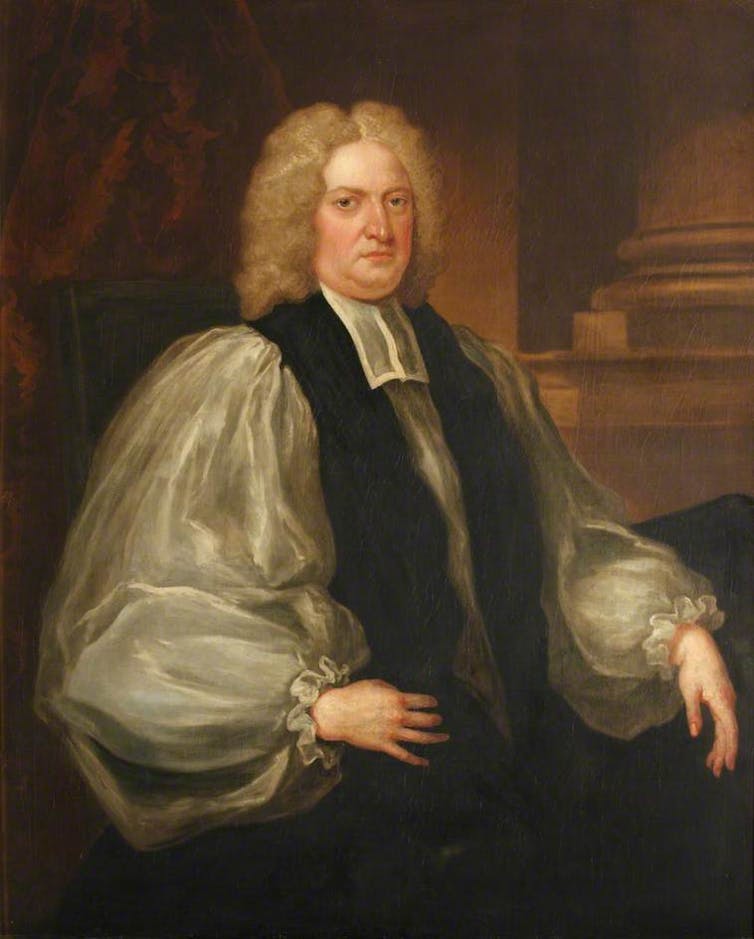
A portrait of Edmund Gibson, the bishop of London, attributed to English portraitist John Vanderbank. (Bodleian Library, University of Oxford)
Some deemed these measures unnecessary. “Infection may have killed its thousands,” wrote one anonymous author, “but shutting up hath killed its ten thousands …”
Edmund Gibson, the bishop of London and an apologist for the government, disagreed. “Where the disease is desperate,” he wrote, “the remedy must be so too.” As such, he wrote, there was no point dwelling “upon rights and liberties, and the ease and convenience of mankind, when there was plague hanging over our heads.”
Social dislocation was an inevitable result — a necessary evil. But as medieval and early modern experiences with plague remind us, it is not a permanent fixture.
Some deemed these measures unnecessary. “Infection may have killed its thousands,” wrote one anonymous author, “but shutting up hath killed its ten thousands …”
Edmund Gibson, the bishop of London and an apologist for the government, disagreed. “Where the disease is desperate,” he wrote, “the remedy must be so too.” As such, he wrote, there was no point dwelling “upon rights and liberties, and the ease and convenience of mankind, when there was plague hanging over our heads.”
Social dislocation was an inevitable result — a necessary evil. But as medieval and early modern experiences with plague remind us, it is not a permanent fixture.
Visiting Fellow at the Pontifical Institute of Mediaeval Studies, Toronto, and Associate Professor in Medieval History, The University of Queensland
University of Queensland provides funding as a member of The Conversation AU.
What can the Black Death tell us about the global economic consequences of a pandemic?
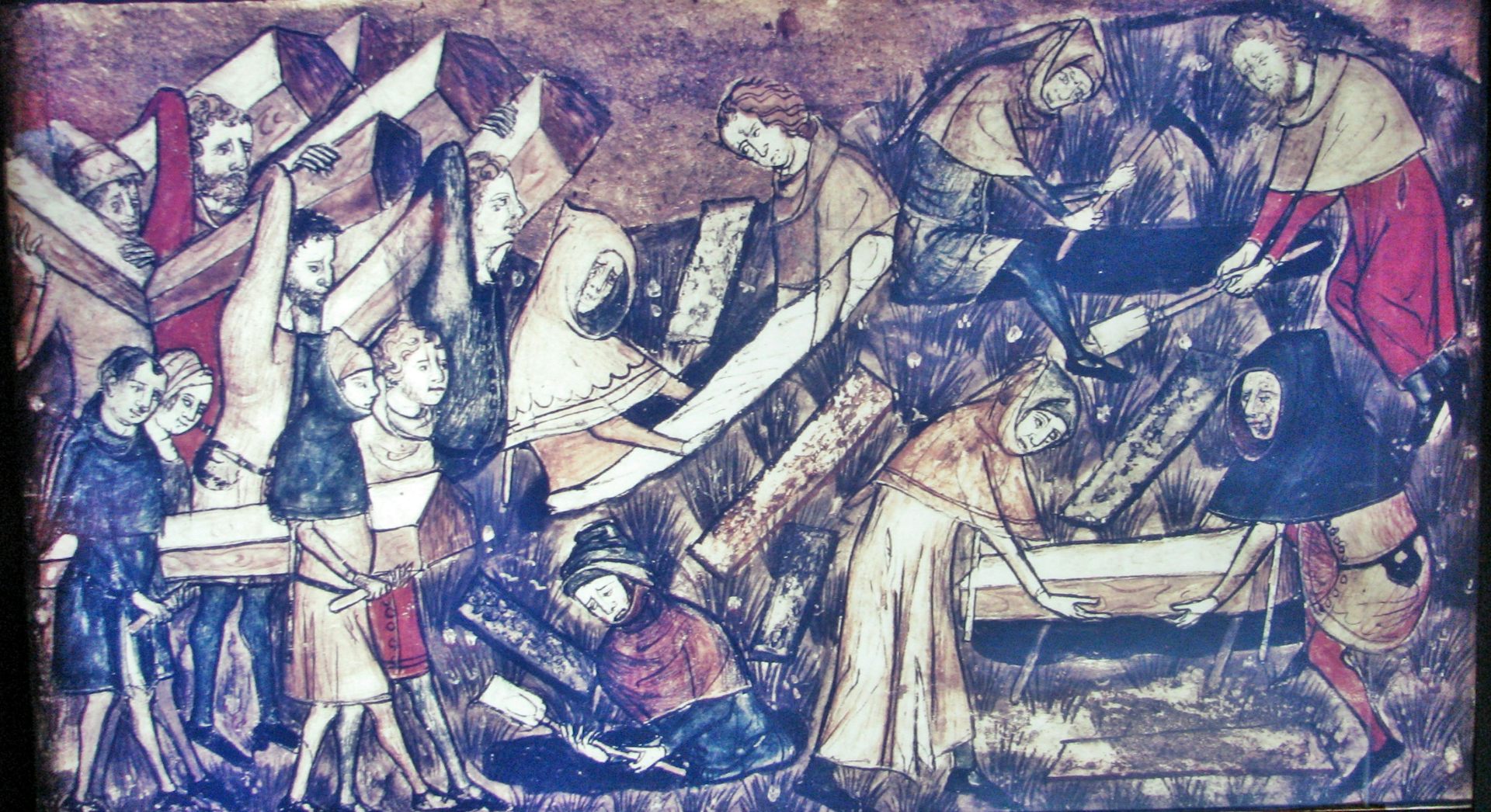
Miniature by Pierart dou Tielt
University of Queensland provides funding as a member of The Conversation AU.
What can the Black Death tell us about the global economic consequences of a pandemic?

Miniature by Pierart dou Tielt
March 3, 2020

Concerns over the spread of the novel coronavirus have translated into an economic slowdown. Stock markets have taken a hit: the UK’s FTSE 100 has seen its worst days of trading for many years and so have the Dow Jones and S&P in the US. Money has to go somewhere and the price of gold – seen as a stable commodity during extreme events – reached a seven-year high.
A look back at history can help us consider the economic effects of public health emergencies and how best to manage them. In doing so, however, it is important to remember that past pandemics were far more deadly than coronavirus, which has a relatively low death rate.
Without modern medicine and institutions like the World Health Organization, past populations were more vulnerable. It is estimated that the Justinian plague of 541 AD killed 25 million and the Spanish flu of 1918 around 50 million
By far the worst death rate in history was inflicted by the Black Death. Caused by several forms of plague, it lasted from 1348 to 1350, killing anywhere between 75 million and 200 million people worldwide and perhaps one half of the population of England. The economic consequences were also profound.
‘Anger, antagonism, creativity’
It might sound counter-factual – and this should not minimise the contemporary psychological and emotional turmoil caused by the Black Death – but the majority of those who survived went on to enjoy improved standards of living. Prior to the Black Death, England had suffered from severe overpopulation.
Following the pandemic, the shortage of manpower led to a rise in the daily wages of labourers, as they were able to market themselves to the highest bidder. The diets of labourers also improved and included more meat, fresh fish, white bread and ale. Although landlords struggled to find tenants for their lands, changes in forms of tenure improved estate incomes and reduced their demands.
But the period after the Black Death was, according to economic historian Christopher Dyer, a time of “agitation, excitement, anger, antagonism and creativity”. The government’s immediate response was to try to hold back the tide of supply-and-demand economics.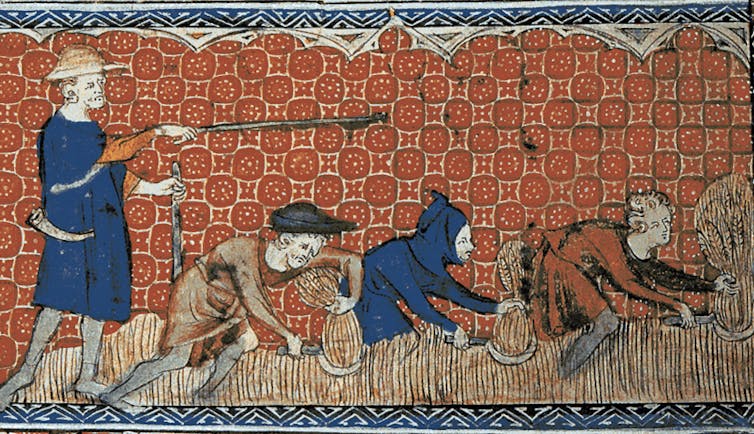
A look back at history can help us consider the economic effects of public health emergencies and how best to manage them. In doing so, however, it is important to remember that past pandemics were far more deadly than coronavirus, which has a relatively low death rate.
Without modern medicine and institutions like the World Health Organization, past populations were more vulnerable. It is estimated that the Justinian plague of 541 AD killed 25 million and the Spanish flu of 1918 around 50 million
By far the worst death rate in history was inflicted by the Black Death. Caused by several forms of plague, it lasted from 1348 to 1350, killing anywhere between 75 million and 200 million people worldwide and perhaps one half of the population of England. The economic consequences were also profound.
‘Anger, antagonism, creativity’
It might sound counter-factual – and this should not minimise the contemporary psychological and emotional turmoil caused by the Black Death – but the majority of those who survived went on to enjoy improved standards of living. Prior to the Black Death, England had suffered from severe overpopulation.
Following the pandemic, the shortage of manpower led to a rise in the daily wages of labourers, as they were able to market themselves to the highest bidder. The diets of labourers also improved and included more meat, fresh fish, white bread and ale. Although landlords struggled to find tenants for their lands, changes in forms of tenure improved estate incomes and reduced their demands.
But the period after the Black Death was, according to economic historian Christopher Dyer, a time of “agitation, excitement, anger, antagonism and creativity”. The government’s immediate response was to try to hold back the tide of supply-and-demand economics.

Life as a labourer in the 14th century was hard. British Library
This was the first time an English government had attempted to micromanage the economy. The Statute of Labourers law was passed in 1351 in an attempt to peg wages to pre-plague levels and restrict freedom of movement for labourers. Other laws were introduced attempting to control the price of food and even restrict which women were allowed to wear expensive fabrics.
But this attempt to regulate the market did not work. Enforcement of the labour legislation led to evasion and protests. In the longer term, real wages rose as the population level stagnated with recurrent outbreaks of the plague.
Landlords struggled to come to terms with the changes in the land market as a result of the loss in population. There was large-scale migration after the Black Death as people took advantage of opportunities to move to better land or pursue trade in the towns. Most landlords were forced to offer more attractive deals to ensure tenants farmed their lands.
A new middle class of men (almost always men) emerged. These were people who were not born into the landed gentry but were able to make enough surplus wealth to purchase plots of land. Recent research has shown that property ownership opened up to market speculation.
The dramatic population change wrought by the Black Death also led to an explosion in social mobility. Government attempts to restrict these developments followed and generated tension and resentment.
Meanwhile, England was still at war with France and required large armies for its campaigns overseas. This had to be paid for, and in England led to more taxes on a diminished population. The parliament of a young Richard II came up with the innovative idea of punitive poll taxes in 1377, 1379 and 1380, leading directly to social unrest in the form of the Peasants’ Revolt of 1381.
This was the first time an English government had attempted to micromanage the economy. The Statute of Labourers law was passed in 1351 in an attempt to peg wages to pre-plague levels and restrict freedom of movement for labourers. Other laws were introduced attempting to control the price of food and even restrict which women were allowed to wear expensive fabrics.
But this attempt to regulate the market did not work. Enforcement of the labour legislation led to evasion and protests. In the longer term, real wages rose as the population level stagnated with recurrent outbreaks of the plague.
Landlords struggled to come to terms with the changes in the land market as a result of the loss in population. There was large-scale migration after the Black Death as people took advantage of opportunities to move to better land or pursue trade in the towns. Most landlords were forced to offer more attractive deals to ensure tenants farmed their lands.
A new middle class of men (almost always men) emerged. These were people who were not born into the landed gentry but were able to make enough surplus wealth to purchase plots of land. Recent research has shown that property ownership opened up to market speculation.
The dramatic population change wrought by the Black Death also led to an explosion in social mobility. Government attempts to restrict these developments followed and generated tension and resentment.
Meanwhile, England was still at war with France and required large armies for its campaigns overseas. This had to be paid for, and in England led to more taxes on a diminished population. The parliament of a young Richard II came up with the innovative idea of punitive poll taxes in 1377, 1379 and 1380, leading directly to social unrest in the form of the Peasants’ Revolt of 1381.

Peasants revolting in 1381. Miniature by Jean de Wavrin
This revolt, the largest ever seen in England, came as a direct consequence of the recurring outbreaks of plague and government attempts to tighten control over the economy and pursue its international ambitions. The rebels claimed that they were too severely oppressed, that their lords “treated them as beasts”.
Lessons for today
While the plague that caused the Black Death was very different to the coronavirus that is spreading today, there are some important lessons here for future economic growth. First, governments must take great care to manage the economic fallout. Maintaining the status quo for vested interests can spark unrest and political volatility.
Second, restricting freedom of movement can cause a violent reaction. How far will our modern, mobile society consent to quarantine, even when it is for the greater good?
Plus, we should not underestimate the knee-jerk, psychological reaction. The Black Death saw an increase in xenophobic and antisemitic attacks. Fear and suspicion of non-natives changed trading patterns.
There will be winners and losers economically as the current public health emergency plays out. In the context of the Black Death, elites attempted to entrench their power, but population change in the long term forced some rebalancing to the benefit of labourers, both in terms of wages and mobility and in opening up the market for land (the major source of wealth at the time) to new investors. Population decline also encouraged immigration, albeit to take up low skilled or low-paid jobs. All are lessons that reinforce the need for measured, carefully researched responses from current governments.
This revolt, the largest ever seen in England, came as a direct consequence of the recurring outbreaks of plague and government attempts to tighten control over the economy and pursue its international ambitions. The rebels claimed that they were too severely oppressed, that their lords “treated them as beasts”.
Lessons for today
While the plague that caused the Black Death was very different to the coronavirus that is spreading today, there are some important lessons here for future economic growth. First, governments must take great care to manage the economic fallout. Maintaining the status quo for vested interests can spark unrest and political volatility.
Second, restricting freedom of movement can cause a violent reaction. How far will our modern, mobile society consent to quarantine, even when it is for the greater good?
Plus, we should not underestimate the knee-jerk, psychological reaction. The Black Death saw an increase in xenophobic and antisemitic attacks. Fear and suspicion of non-natives changed trading patterns.
There will be winners and losers economically as the current public health emergency plays out. In the context of the Black Death, elites attempted to entrench their power, but population change in the long term forced some rebalancing to the benefit of labourers, both in terms of wages and mobility and in opening up the market for land (the major source of wealth at the time) to new investors. Population decline also encouraged immigration, albeit to take up low skilled or low-paid jobs. All are lessons that reinforce the need for measured, carefully researched responses from current governments.
Authors

Adrian R. Bell
Chair in the History of Finance and Research Dean, Prosperity and Resilience, Henley Business School, University of Reading

Chair in the History of Finance and Research Dean, Prosperity and Resilience, Henley Business School, University of Reading
Andrew Prescott
Professor of Digital Humanities, University of Glasgow

Professor of Digital Humanities, University of Glasgow
Helen Lacey
Lecturer in Late Medieval History, University of Oxford
Disclosure statement
Adrian R. Bell receives funding from the AHRC and previously from the ESRC.
Andrew Prescott receives funding from the Arts and Humanities Rsearch Council.
Helen Lacey receives funding from the AHRC.
Lecturer in Late Medieval History, University of Oxford
Disclosure statement
Adrian R. Bell receives funding from the AHRC and previously from the ESRC.
Andrew Prescott receives funding from the Arts and Humanities Rsearch Council.
Helen Lacey receives funding from the AHRC.
No comments:
Post a Comment